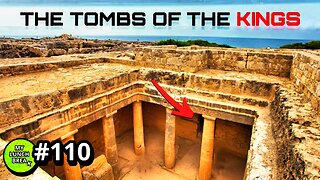Premium Only Content

Volcanic sulfur spilling into the sea at Methana, Greece
Enjoy a flight over a strange sight.
The Greek volcanic pool made of sulfur spilling into the sea. We fly over Methana of Trizinia,
The Methana Peninsula is located in the northeast part of the Peloponnese. The peninsula is famous for its baths and the volcano in the village of Kameni Chora. There are about 30 volcanic structures on the peninsula, and the last volcanic activity was underwater in 1700, in the north in front of the Methana.
Along with the volcanoes of Milos, Santorini and Nisyros, Methana belongs to the volcanic arc of the Southern Aegean, which is related to the most important geothermal fields of Greece (Sousaki - Methana - Milos / Kimolos / Polaiigos - Santorini and Santorini) as an active volcano. The Methana Peninsula is located at the western end of this volcanic arc and has significant geothermal potential, but not fully explored.
In Methana there are about 60 km of marked trails.
Methana is rich in prehistoric and ancient findings. In the chapel of Saints Constantine and Helen, 1.5 km from Loutropolis Methana, in 1990, on the foundations of a small church, a prehistoric settlement of the Mycenaean Era of the 14th and 13th centuries was discovered. B.C. In one of the buildings of the settlement were found tributes (figurines and jewels), which are believed to have been a place of worship of prehistoric deity, and possibly of Neptune. The findings of the excavation are on display at the Piraeus Archaeological Museum. On the hill of Paleokastro, near Vathi, are the ruins of the Acropolis of ancient Methana, with its well-preserved volcanic rock walls and well-preserved gate, built in the 4th to 3rd centuries. BC, from the time of the Peloponnesian War. Findings show that the area was first inhabited by the Neolithic period (5,000 BC). The few excavations at the Acropolis of ancient Methana brought to light fragments of Mycenaean vessels. Also visible ruins of ancient houses are preserved in the sea, from the sunken city of Methana, including the pier of the ancient port. Among the underwater ancient ruins, there are Byzantine churches, which means that the settlements were made in the early AD. years. According to archaeologists, the ancient city of Methana had about 700 houses.
-
 0:12
0:12
slavatsarev
2 years agoVolcanic Tornado
5 -
 0:15
0:15
ViralHog
2 years ago $0.15 earnedDog Startles Baby into Spilling Water
3711 -
 24:08
24:08
MYLUNCHBREAK CHANNEL PAGE
1 day agoUnder The Necropolis - Pt 4
148K31 -
 19:52
19:52
Adam Does Movies
9 hours ago $4.43 earnedEmilia Pérez Movie Review - It's Uniquely Awful
44.9K3 -
 20:07
20:07
BlackDiamondGunsandGear
15 hours agoSPRINGFIELD ECHELON COMPACT / NOT GOOD
46K3 -
 1:05:06
1:05:06
Man in America
16 hours agoThe Terrifying Truth Behind Chemical Fog, Wildfire Smoke & Chemtrails w/ Dr. Robert Young
44.4K55 -
 2:54:47
2:54:47
Tundra Tactical
9 hours ago $11.85 earnedSHOT Show 2025 Wrap Up!! On The Worlds Okayest Gun Live Stream
68K3 -
 LIVE
LIVE
Right Side Broadcasting Network
1 day agoLIVE REPLAY: President Donald J. Trump Holds His First Rally After Inauguration in Las Vegas - 1/25/25
3,272 watching -
 2:55:24
2:55:24
Jewels Jones Live ®
1 day agoWEEK ONE IN REVIEW | A Political Rendezvous - Ep. 107
133K41 -
 1:33:29
1:33:29
Michael Franzese
1 day agoTrump Wastes No Time: Breaking Down Trump’s First Week Executive Orders | LIVE
141K101